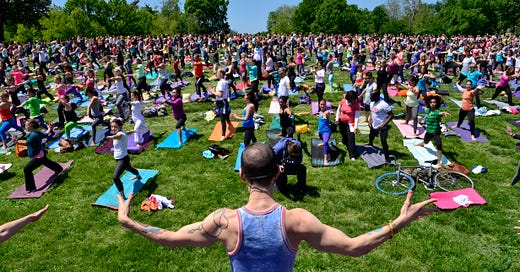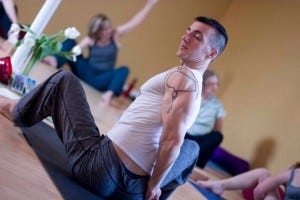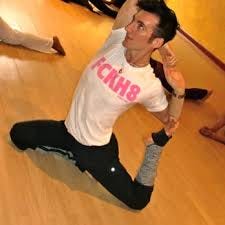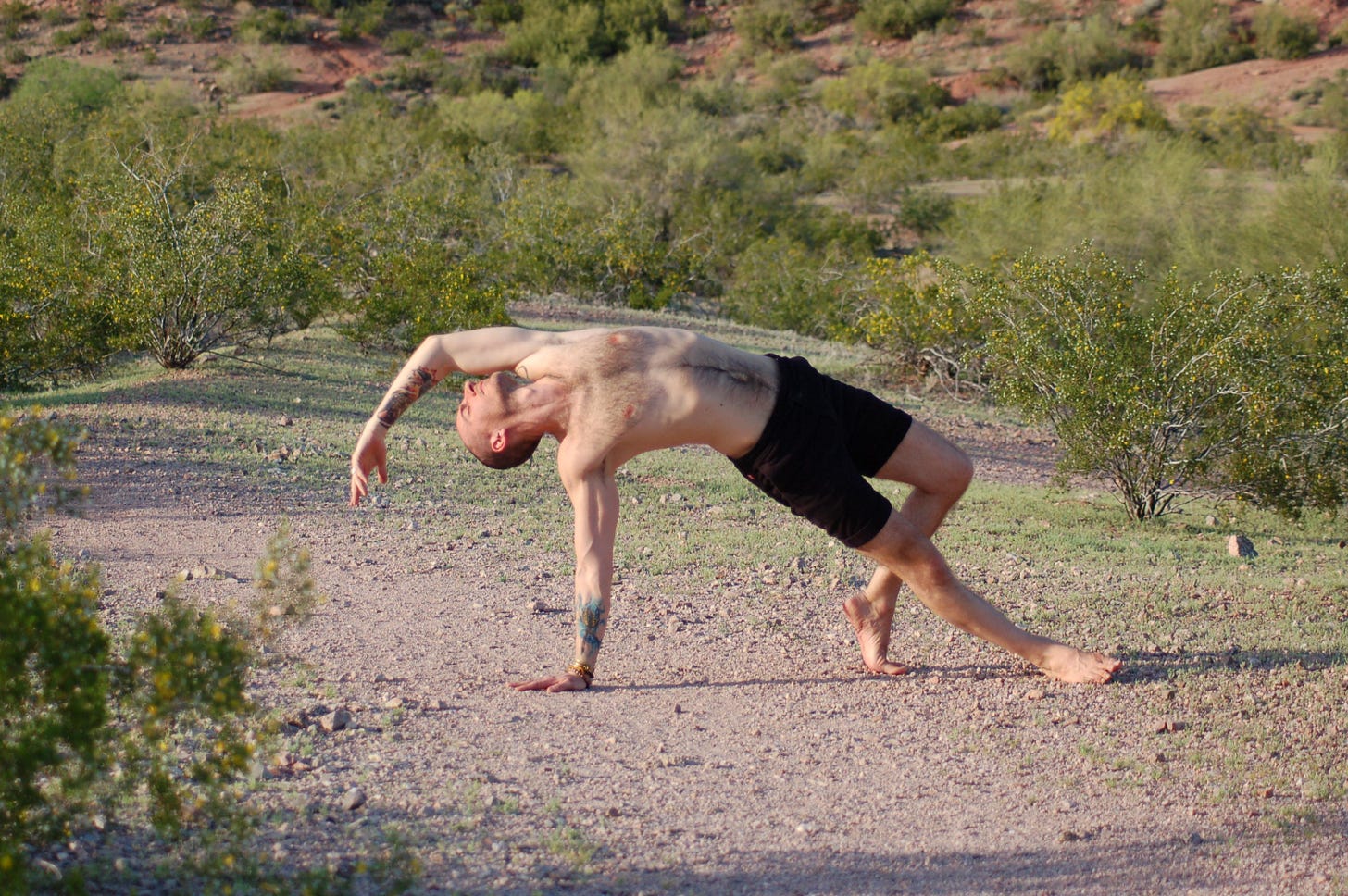I did my first Sun Salute when I was 12. My father had recently moved the family to Pittsburgh for a job opportunity, and that summer, I went to a theater camp for middle and high schoolers. For much of the day, grades were separated out (too bad because that Italian-American high school boy was a dreamboat), but in the morning, on the large stage, illuminated by work lights, we all gathered to do Surya Namaskar A and B, five rounds each.
I loved it – the movement, the breath, the way it made me feel mentally – so much so that after camp was over, sequestered at home in a dismal suburb, the kind of neighborhood my parents always chose, a mid-century fantasy of achievement, I practiced on my own. School hadn’t started yet, so every morning, once my father and crazy stepmother were gone, I exhaled and bowed.
Throughout high school and my early 20s, I fiddled with yoga – a class here and there, some practice on my own, the continued sun salutes – and when I was in my latter 20s, an actor with a dance/movement-intensive theater company, I bought B.K.S. Iyengar’s seminal book Light On Yoga and practiced regularly, using it as a warm-up before shows, instead of the exhausting workout led by our brilliant, and merciless, choreographer.
I found yoga when it was still a refuge for assorted weirdos – artists of all stripes; patchouli-scented vegetarians; bulgur-cooking socialists; people who shared a row house, Indian gods propped around the rooms with incense bowls smoking before them; activists who read Paramahansa Yogananda’s Autobiography of a Yogi or a copy of the Bhagavad Gita on the bus; Radical Faeries meditating in the park after a hookup in the bushes.
By the time I decided to apply for a teacher training program, the landscape had begun to shift. Lululemon darkened the sky in storm clouds of athleisure wear. Yoga studios popped up in more neighborhoods and suburbs, though not yet on every block, in every strip mall. Gyms embraced the trend, too, but demanded there be no chanting, no mention of philosophy.
When I answered all the training program’s application questions, I waited, nervous I wouldn’t be accepted. I didn’t have a strong studio practice. I’m a solitary type and, as an actor at the time not flush with cash, I did my own thing with Iyengar’s detailed instructions to guide me. Of course, I needn’t have worried. Teacher trainings aren’t concerned with who they get, so long as the prospectives pay the exorbitant fees to become, more often than not, bland teachers. It’s a cash cow for studios. It’s a disaster for yoga. (As is the racket of Yoga Alliance, an alleged governing body meant to certify yoga teachers, create some quality control, charge their members, but not even attempt to create collective bargaining power and get the thousands of hard-working instructors some health insurance or a better pay scale.) With every studio running a training program once or twice a year, the market is flooded with insipid teachers who, like all Americans, want to make money off what made them feel good. I knew lawyers who quit their firms, people at the World Bank who walked away from their careers. It was madness, and now, being a yoga teacher almost has no meaning. You can cue an updog? So can my cat.
As a teacher, I was deep in. I taught packed classes. I led sold-out retreats. I did workshops. I was bored. Not with the practitioners. Not with the subject. With the scene and the terrible blend of capitalism and spirituality (an anodyne word).
Student after student came to me and asked whether or not they should attend a training program because they wanted to “deepen” their practice.
My response, always: “Teacher training programs don’t deepen your practice. They teach you how to be a teacher.”
There were few places for these practitioners to go, to find the breath work, meditation, mythology, or the texts of India related to yoga (which is just Hinduism – the jig is up, everyone, the yogic arts are not separate from spirituality and, dare I say it, god, although a very different conception from that of Judeo-Christian codswallop).
I’d thrown myself down the well of yoga, transfixed by the wisdom therein and soon developed a variety of programs and workshops to create something beyond the asana. We explored the Upanishads, the Yoga Sutras (taught so poorly or mentioned so often as a punchline to savasana that I detested it for years), the Ramayana, the stores of Devi, Lord Shiva, historical personages. In the beginning I did this in my apartment, all of us sitting around on the floor. People were hungry for the melodramas, the philosophical conundrums, the dive into the wreck of themselves.
After almost 10 years of teaching, my husband and I moved out west to Arizona, a chance to try a different life, away from the grind that was Washington, D.C., and Philly, his hometown. We needed a good thawing-out, plus I’d had a stroke the year before and with all the retreats, classes, events, I was run-down. As much as I had wanted to take a break from all of it, there were $10,000 worth of medical bills to pay, even with insurance, so I never had the chance.
My final class in D.C. was a strange one. For years, on Martin Luther King weekend, I taught in honor of him and his legacy, punctuating the music with recordings of speeches he’d given – the big one, yes, but others, equally rousing, equally provocative even today. This annual class usually generated high emotions and a palpable energy in the room, but during my final class, as the wheel of yoga had begun its turn towards the purely physical, the purely materialistic, I looked around at a room full of strangers, none of them affected by the experience, each one dead in the eyes, each one disappearing into their phones as soon as they’d murmured “Namaste.”
Arizona was worse yet. Practitioners there were more interested in their ass than their minds. I dropped out of teaching. My only investment in that world was personal, a continued study of Jyotish, India’s astrological system in which you can find the philosophy, the mythology, the wisdom of the sub-continent. Seven years later, I took a class at a Phoenix studio and, through good fortune, found a marvelous teacher, Jenny Guzon-Bae. She gave me back a love for group classes (or at least hers), a love for asana. Each week, the room was full of adults, people often in their 30s, 40s, and 50s, a refreshing change, and well-versed in the philosophy, Guzon-Bae has an easy hand when weaving the physical and the spiritual together.
Moving back to New York, I was hopeful of what I’d find here.
But Core Power is everywhere, a corporation that, when it first came to D.C., yoga teachers and practitioners thought it a joke. I tried out one studio in town with a great location and beautiful physical space, but as the yoga scene revenants floated into the studio, I shuddered. When I walked in, I saw an emaciated white woman “dancing;” I nearly tucked and rolled down the steps. Someone else was friendly and talked to me, asking me if I wanted to go to tea afterwards; I contemplated the injuries I’d sustain if I hurled myself out the 3rd-floor window. (As a teacher, I quickly learned that a request for tea was the kiss of death. Over a cup of glorified dishwater, glassy-eyed yogis wrung their hands about animal cruelty or wanted to know whether or not they should leave their relationship and join an ashram. At those tea dates, I came to envy Litvinenko.) More than one teacher at the studio taught a sequence meant to entertain or be innovative rather than good. Then there was the sing-song voice, a strange, yoga-teacher intonation that sounds like an inane Mandarin. People folded their hands over their hearts and swayed, others sighed in backbends as if they were getting fingered (and not particularly well, it seems), after class men called each other “brother” in sultry whispers. I half-expected someone to come around with Dixie cups full of Kool-Aid.
In New York and everywhere else in America you can find bootcamp yoga (because work-obsessed westerners need to go harder), hot yoga (because that’s what you should do during a sweltering summer when the air is palled with smoke from forest fires), naked yoga (because gay men don’t have any other opportunities to look at dick), beer yoga (because straight, white, bro’s need another excuse to act like troglodytes), and goat yoga (for fuck’s sake).
I’m not saying all this because I like to flex my bitchy vocabulary (okay, okay, maybe that, too), but because I deeply love the yogic arts. I think India’s spirituality is, for my money’s worth, the most refined exploration of consciousness I’ve yet found, and everything in the culture emerges from and is woven into that exploration. Sitting at a concert of Indian music by K. Sridhar, a sarod player, listening to a note reverberate into silence, it struck me that this diminuendo was the meditative journey, from the gross to the subtle to the void that is always full. I can’t stomach watching this richness polluted by tantrum yoga (tragically, that’s not a joke). To paraphrase cultural critic Daniel Mendelsohn, critics are such because they adore the arts with an idolatrous passion and so hate the intellectual laziness, avarice, and shallow creativity that degrades those subjects.
At this juncture, as everyday we’re assaulted by the brutish dictums of the Caligula from Queens, we need practices of beauty, clarity, strength, wonder, and complexity to meet the moment, to align ourselves to purpose, to help us understand that the story of our lives, the story of our communities, the story even of our nation and our world, the story we find ourselves in is not the full story – it’s just the story we’re currently being told. With expanded consciousness, with discernment, with a commitment to practices like yoga in all its permutations, we can empower the mind and then speech; we can revive a better story, we can tell a new one.
In the Brihadaranyaka Upanishad, a wise king, Janaka, questions a holy man, Yajñavalkya, and when they discuss speech, the king asks, “What constitutes knowledge, Yajñavalkya?”
“Speech itself, Your Majesty. For surely, Your Majesty, it is through speech that we come to know a counterpart. Rgveda, Yajurveda, Samaveda, the Atharava-Angiras, histories, ancient tales, sciences, hidden teachings, verses, aphorisms, explanations, and glosses; offerings and oblations; food and drink; this world and the next world; and all beings – it is through speech, Your Majesty, that we come to know all these.” (Trans. Patrick Olivelle)
The goddess Vac is speech and the vehicle of knowledge; she’s called the mother of the Vedas, “containing all the worlds within herself,” as described by Indologist Alain Daniélou. She blesses us when we are silent, when we listen, when we learn, when we reflect, because wisdom comes from all this. Do your asana, but do it to make your body a tuning fork of sagacity. Meditate to find the depth of silence from which springs Vac. When she arrives on your tongue and gives birth to the fire of your words, you have the chance to create a life of meaning beyond common custom, beyond the government, beyond capitalism, beyond the yoga scene, beyond social media, beyond the cutesy memes we Substackers pepper throughout our essays to keep your flickering attention.
As my Vedic astrology teacher, Brendan Feeley said to me, “Dharma is how we make meaning out of experience.” Purpose is not something given to you, it’s something you create, maybe something you earn, and only when you ruminate, only when you get quiet, only when you rebuke the cheap and the shallow, will your purpose be revealed to you. Yoga comes from a Sanskrit word meaning “to yoke together,” and ultimately you’re yoking the self, the personality of you, to a larger consciousness – the Unified Field of quantum physics, the Great Mother, a divinity, whatever term makes your personality comfortable. Everyone’s ultimate purpose, ultimate dharma, ultimate meaning is to differentiate ourselves from the silliness, from the messiness of our experience and recognize, even tell, a new story, one that encompasses “all the worlds,” all the possibilities of who and what we are.
So much better than wiping someone else’s sweat off your mat.








I love, love, love this... It is extremely well-written, of course, but also erudite and elucidating. Each of these seems to be better than the last. Again, Kudos...
You speak so much truth. Beautiful.